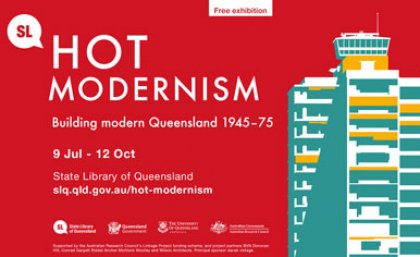
Innovative teaching and research technologies are bringing mid-20th Century sub-tropical architecture to life at the State Library of Queensland.
Hot Modernism, an interactive exhibition on Queensland’s post-war architecture, uses technology and resources from The University of Queensland’s Schools of Architecture and Information Technology to form a multi-dimensional look at architecture trends from 1945-75.
Architecture, Theory, Criticism and History Research Centre fellows Dr Deborah van der Plaat and Dr Janina Gosseye collaborated with Kevin Wilson and Gavin Bannerman from the State Library of Queensland to create the exhibition.
“This multi-dimensional and multi-media exhibition captures the stories of the state’s mid-20th century architecture, a time when the traditional timber Queenslander made way for modern bungalows, concrete high rises, expressways and shopping precincts,” Dr van der Plaat said.
“Visitors can explore a full-scale replica of the Jacobi House designed by Brisbane architects Hayes and Scott in 1957, and experience a ‘modern’ sitting room furnished with genuine mid-century Danish furniture.
“Original drawings, 3D models, short films and photographs offer insight into the people, projects and ideas that transformed architecture across the state’s suburbs, towns and cities.”
The project, funded by an Australian Research Council Linkage Grant, has also led to a Queensland architecture digital archive and a book to be published later this year.
“Post-World War II was an innovative and expansive period in Queensland’s history, and although the architecture of the time reflected this, reliable archival resources were difficult to source,” Dr van der Plaat said.
“Working with the eResearch lab, we created the digital archive, connecting oral histories of post-war architects with original drawings, photographs and primary texts.
“We also developed digital tools that offered new ways of interpreting this material.”
“The project also gave students the opportunity to work with architects from the period to digitally recreate lost projects and to document the era’s interests and influences.”
Co-curator Dr Gosseye said the project had the additional benefit of building community awareness of modern Queensland architecture.
“The architecture of modern Queensland is generally not recognised by the public as historically or culturally significant and thus worthy of preservation,” she said.
“As a consequence, important buildings of the period are increasingly lost to new developments with little protest.”
Members of the public are invited to enter a “Hot and Bothered” film competition, submitting a three-minute short on their favourite Queensland post-war building. The competition closes at the end of August and the top prize is $1500.
Hot Modernism is open daily from 10am - 5pm at the State Library until 12 October. Entry is free.
This project was a collaboration between the SLQ, UQ and a several industry partners. For a full list of those involved, visit www.architecture.uq.edu.au/hot-modernism
Media: Marketing and Communications Manager Trent Leggatt, 3346 9976 or 0413 909 026, t.leggatt@uq.edu.au
.jpg)

